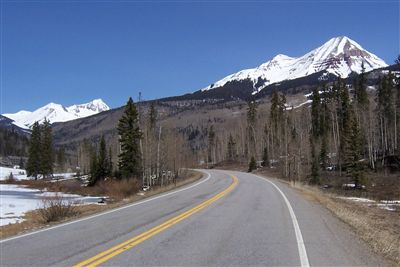I'll admit it right here, right now: Durango cyclists have an (unfair?) advantage for a number of reasons, but the one I really like is the proximity to the million dollar highway, US Hwy 550 between Durango Mountain Resort and Ouray. The road strikes fear into those driving trucks, RVs, or anyone pulling trailers. Anyone from Iowa for that matter ;) The route hits 3 major passes: Coal Bank, Molas, and Red Mountain. They are all between 10,600 and 11,000'.
Since the elevation is so high, power output is much reduced. According to one performance model (http://www.midweekclub.com/powerFAQ.htm#Q17), at 11,000' you have between 77% and 81% of your sea level threshold power and not a watt more. Some think this is bad for training - half of the reasoning of the live high/train low model is based on such reasoning. But I say bull hockey. Guys that train at elevation in these parts kick some serious booty. Ned is one of them, training high hasn't hurt his palmares! One thing I've noticed when training at elevation is that recovery is faster than a similar TSS workout at lower elevations. In the latter, FT is higher so absolute work performed is much higher - and I presume that accounts for more muscle damage (don't quote me on that though, I'm no physiologist). Of course I mix it up, interjecting high intensity stuff at (relatively) lower elevations mid-week. It's my opinion though, that prolonged work at elevation builds FT power because it's all relative - FT relative to available Os. At elevation I can do a helluva lot more "threshold" work than lower elevations.
In any case, after a serious block of elevation work last year I saw gains beyond expecations, so I'm at it again. Today's ride was 111 miles, Durango to Red Mtn pass and back. Total ride time was about 6:20. Not sure how much climbing, but by Silverton there is over 5,000' and that was just the first 2:40, only 2 of 5 passes climbed...
The aesthetic perks are huge. It's awesome country any time of year up there...right now it's mud season at the lower elevations, and still winter at higher elevations.
This shot is just before the base of Coal Bank Pass. Engineer Mountain on the right.

The top of Red Mountain pass is still wintry. Last year snowpack was more than double this amount.

6 years ago I spent a summer guiding rafts down the upper Animas river. This is the first view the crews get, looking down the daunting Animas River gorge from Silverton.

Now you know another reason you should groan when a Durango cyclist shows up to your next event!